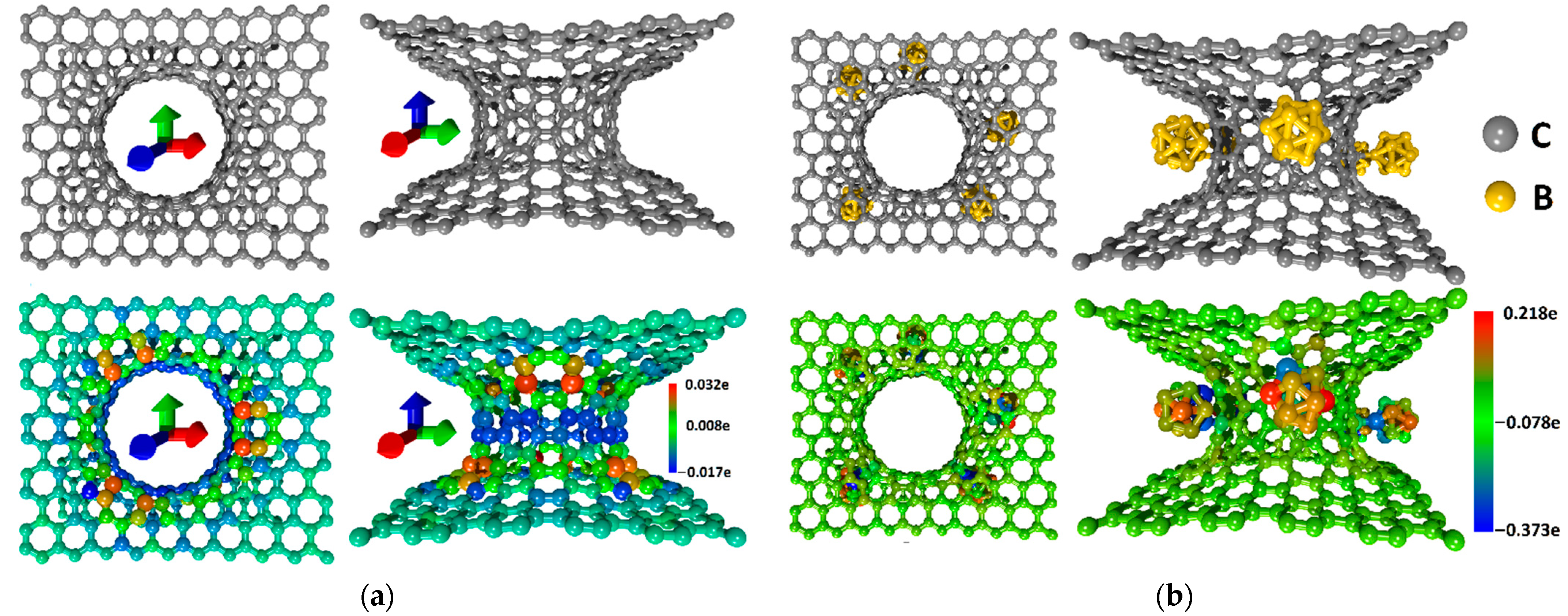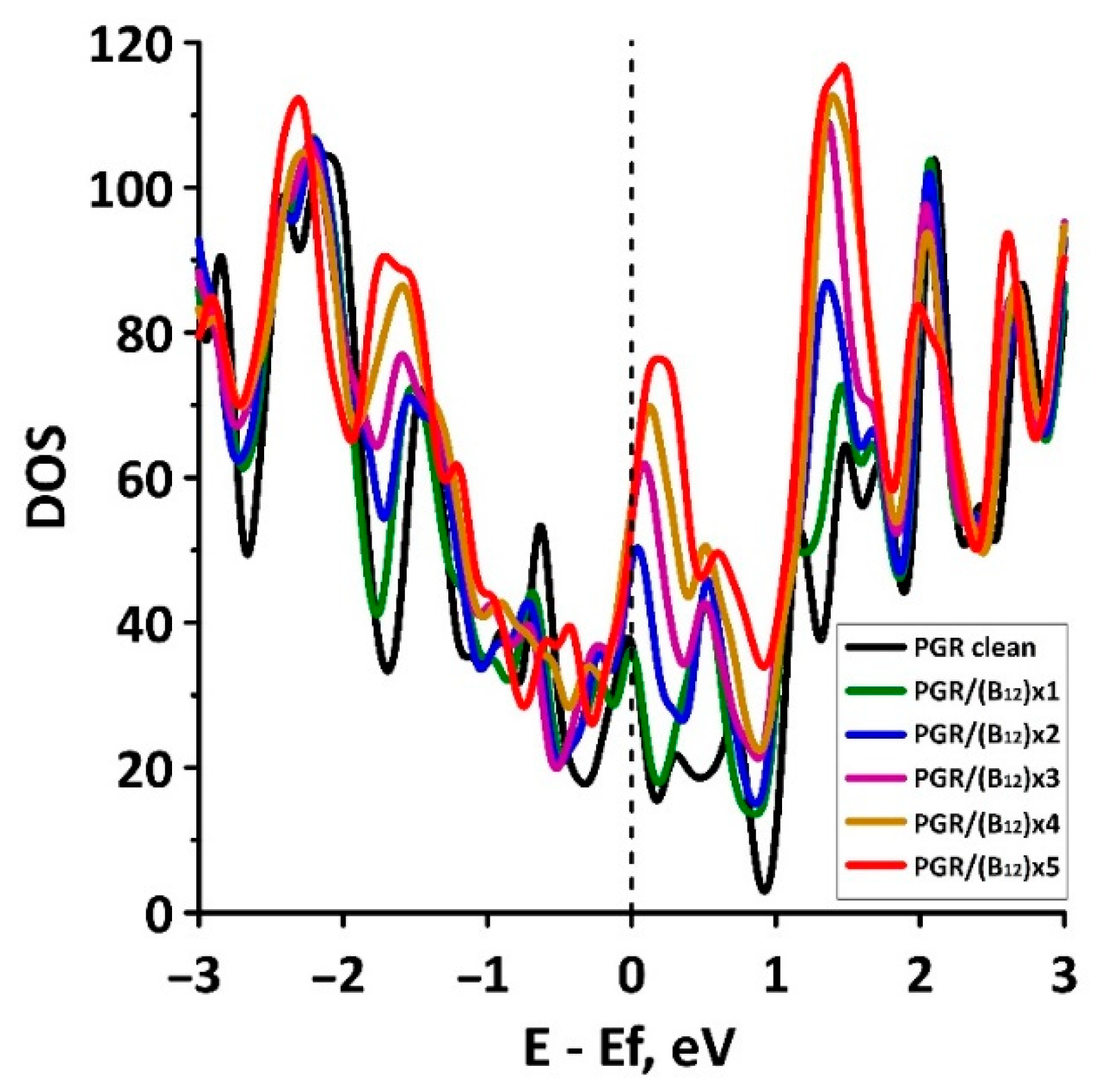Boron-Decorated Pillared Graphene as the Basic Element for Supercapacitors: An Ab Initio Study
Abstract
1. Introduction
2. Materials and Methods
3. Results and Discussion
4. Conclusions
Author Contributions
Funding
Institutional Review Board Statement
Informed Consent Statement
Data Availability Statement
Conflicts of Interest
References
- Poonam Sharma, K.; Arora, A.; Tripathi, S.K. Review of supercapacitors: Materials and devices. J. Energy Storage 2019, 21, 801–825. [Google Scholar] [CrossRef]
- Kim, H.-J.; Krishna, T.; Zeb, K.; Rajangam, V.; Gopi, C.V.V.M.; Sambasivam, S.; Raghavendra, K.V.G.; Obaidat, I.M. A Comprehensive Review of Li-Ion Battery Materials and Their Recycling Techniques. Electronics 2020, 9, 1161. [Google Scholar] [CrossRef]
- Manthiram, A. A reflection on lithium-ion battery cathode chemistry. Nat. Commun. 2020, 11, 1550. [Google Scholar] [CrossRef] [PubMed]
- Miller, J.R.; Simon, P. MATERIALS SCIENCE: Electrochemical Capacitors for Energy Management. Science 2008, 321, 651–652. [Google Scholar] [CrossRef]
- Murray, D.B.; Hayes, J.G. Cycle Testing of Supercapacitors for Long-Life Robust Applications. IEEE Trans. Power Electron. 2015, 30, 2505–2516. [Google Scholar] [CrossRef]
- Panda, P.K.; Grigoriev, A.; Mishra, Y.K.; Ahuja, R. Progress in Supercapacitors: Roles of Two Dimensional Nanotubular Materials. Nanoscale Adv. 2020, 2, 70–108. [Google Scholar] [CrossRef]
- Chen, G.Z. Supercapacitor and supercapattery as emerging electrochemical energy stores. Int. Mater. Rev. 2016, 62, 173–202. [Google Scholar] [CrossRef]
- Luryi, S. Quantum capacitance devices. Appl. Phys. Lett. 1988, 52, 501–503. [Google Scholar] [CrossRef]
- Shao, Y.; El-Kady, M.F.; Sun, J.; Li, Y.; Zhang, Q.; Zhu, M.; Wang, H.; Dunn, B.; Kaner, R.B. Design and Mechanisms of Asymmetric Supercapacitors. Chem. Rev. 2018, 118, 9233–9280. [Google Scholar] [CrossRef]
- Ahmed, S.; Ahmed, A.; Rafat, M. Supercapacitor performance of activated carbon derived from rotten carrot in aqueous, organic and ionic liquid based electrolytes. J. Saudi Chem. Soc. 2018, 22, 993–1002. [Google Scholar] [CrossRef]
- Piñeiro-Prado, I.; Salinas-Torres, D.; Ruiz-Rosas, R.; Morallón, E.; Cazorla-Amorós, D. Design of Activated Carbon/Activated Carbon Asymmetric Capacitors. Front. Mater. 2016, 3, 16. [Google Scholar] [CrossRef]
- Pina, A.C.; Amaya, A.; Marcuzzo, J.S.; Rodrigues, A.C.; Baldan, M.R.; Tancredi, N.; Cuña, A. Supercapacitor Electrode Based on Activated Carbon Wool Felt. C J. Carbon Res. 2018, 4, 24. [Google Scholar] [CrossRef]
- Qing, Y.; Jiang, Y.; Lin, H.; Wang, L.; Liu, A.; Cao, Y.; Sheng, R.; Guo, Y.; Fan, C.; Zhang, S.; et al. Boosting the Supercapacitor Performance of Activated Carbon by Constructing Overall Conductive Networks Using Graphene Quantum Dots. J. Mater. Chem. A 2019, 7, 6021–6027. [Google Scholar] [CrossRef]
- Paek, E.; Pak, A.J.; Hwang, G.S. A computational study of the interfacial structure and capacitance of graphene in [BMIM][PF6] ionic liquid. J. Electrochem. Soc. 2013, 160, A1–A10. [Google Scholar] [CrossRef]
- Paek, E.; Pak, A.J.; Kweon, K.E.; Hwang, G.S. On the origin of the enhanced supercapacitor performance of nitrogen-doped graphene. J. Phys. Chem. C 2013, 117, 5610–5616. [Google Scholar] [CrossRef]
- Hirunsit, P.; Liangruksa, M.; Khanchaitit, P. Electronic structures and quantum capacitance of monolayer and multilayer graphenes influenced by Al, B, N and P doping, and monovacancy: Theoretical study. Carbon 2016, 108, 7–20. [Google Scholar] [CrossRef]
- Mousavi-Khoshdel, S.M.; Jahanbakhsh-bonab, P.; Targholi, E. Structural, electronic properties, and quantum capacitance of B, N and P-doped armchair carbon nanotubes. Phys. Lett. A 2016, 380, 3378–3383. [Google Scholar] [CrossRef]
- Chen, L.; Li, X.; Ma, C.; Wang, M.; Zhou, J. Interaction and quantum capacitance of nitrogen/sulfur co-doped graphene: A theoretical calculation. J. Phys. Chem. C 2017, 121, 18344–18350. [Google Scholar] [CrossRef]
- Sun, P.; Wang, R.; Wang, Q.; Wang, H.; Wang, X. Uniform MoS2 Nanolayer with Sulfur Vacancy on Carbon Nanotube Networks as Binder-free Electrodes for Asymmetrical supercapacitor. Appl. Surf. Sci. 2019, 475, 793–802. [Google Scholar] [CrossRef]
- Miao, J.; Dong, X.; Xu, Y.; Zhai, Z.; Zhang, L.; Ren, B.; Liu, Z. Preparation and electrochemical performance of 1,4-naphthaquinone-modified carbon nanotubes as a supercapacitor material. Org. Electron. 2019, 73, 304–310. [Google Scholar] [CrossRef]
- Wang, X.; Wu, D.; Song, X.; Du, W.; Zhao, X.; Zhang, D. Review on Carbon/Polyaniline Hybrids: Design and Synthesis for Supercapacitor. Molecules 2019, 24, 2263. [Google Scholar] [CrossRef]
- Jain, R.; Wadekar, P.H.; Khose, R.V.; Pethsangave, D.A.; Some, S. MnO2@Polyaniline-CNT-boron-doped graphene as a freestanding binder-free electrode material for supercapacitor. J. Mater. Sci. Mater. Electron. 2020, 31, 8385–8393. [Google Scholar] [CrossRef]
- Hao, H.; Xiaogang, S.; Wei, C.; Jie, W.; Xu, L.; Yapan, H.; Chengcheng, W.; Guodong, L. Electrochemical properties of supercapacitors using boron nitrogen double doped carbon nanotubes as conductive additive. Nano 2019, 14, 1950080. [Google Scholar] [CrossRef]
- Maity, C.K.; Sahoo, S.; Verma, K.; Behera, A.K.; Nayak, G.C. Facile functionalization of boron nitride (BN) for the development of high-performance asymmetric supercapacitors. New J. Chem. 2020, 44, 8106–8119. [Google Scholar] [CrossRef]
- Jung, D.; Muni, M.; Marin, G.; Ramachandran, R.; El-Kady, M.F.; Balandin, T.; Kaner, R.B.; Spokoyny, A.M. Enhancing cycling stability of tungsten oxide supercapacitor electrodes via a boron cluster-based molecular cross-linking approach. J. Mater. Chem. A 2020, 8, 18015–18023. [Google Scholar] [CrossRef]
- Banda, H.; Périé, S.; Daffos, B.; Taberna, P.-L.; Dubois, L.; Crosnier, O.; Simon, P.; Lee, D.; Paëpe, G.D.; Duclairoir, F. Sparsely Pillared Graphene Materials for High Performance Supercapacitors: Improving Ion Transport and Storage Capacity. ACS Nano 2019, 13, 1443–1453. [Google Scholar] [CrossRef] [PubMed]
- Wang, W.; Ozkan, M.; Ozkan, C.S. Ultrafast high energy supercapacitors based on pillared graphene nanostructures. J. Mater. Chem. A 2016, 4, 3356–3361. [Google Scholar] [CrossRef]
- Ghosh, K.; Yue, C.Y.; Sk, M.M.; Jena, R.K. Development of 3D Urchin-Shaped Coaxial Manganese Dioxide@Polyaniline (MnO2@PANI) Composite and Self-Assembled 3D Pillared Graphene Foam for Asymmetric All-Solid-State Flexible Supercapacitor Application. ACS Appl. Mater. Interfaces 2017, 9, 15350–15363. [Google Scholar] [CrossRef] [PubMed]
- Jiang, L.; Sheng, L.; Long, C.; Wei, T.; Fan, Z. Functional Pillared Graphene Frameworks for Ultrahigh Volumetric Performance Supercapacitors. Adv. Energy Mater. 2015, 5, 1500771. [Google Scholar] [CrossRef]
- Ordejón, P.; Artecho, E.; Soler, J.M. Self-consistent order-N density-functional calculations for very large systems. Phys. Rev. B 1996, 53, 10441. [Google Scholar] [CrossRef]
- Soler, J.M.; Artecho, E.; Gale, J.D.; Garcýa, A.; Junqera, J.; Ordejón, P.; Sanchez-Portal, D. The SIESTA method for ab initio order-N materials simulation. J. Phys. Condens. Matter 2002, 14, 2745. [Google Scholar] [CrossRef]
- Naveh, Z.M.; Khajehdad, M.M.; Sarmazdeh, M.M. A theoretical study on the chirality detection of serine amino acid based on carbon nanotubes with and without Stone-Wales defects. Struct. Chem. 2019, 31, 455–464. [Google Scholar] [CrossRef]
- Juarez, F.; Dominguez-Flores, F.; Quaino, P.M.; Santos, E.; Schmickler, W. Interactions of ions across carbon nanotubes. Phys. Chem. Chem. Phys. 2020, 22, 10603–10608. [Google Scholar] [CrossRef] [PubMed]
- Chen, Y.R.; Lin, M.K.; Chan, D.H.; Lin, K.B.; Kaun, C.C. Ab Initio and Theoretical Study on Electron Transport through Polyene Junctions in between Carbon Nanotube Leads of Various Cuts. Sci. Rep. 2020, 10, 8033. [Google Scholar] [CrossRef] [PubMed]
- Johnson, D.D. Modified Broyden’s method for accelerating convergence in self-consistent calculations. Phys. Rev. Lett. 1988, 38, 12807. [Google Scholar] [CrossRef] [PubMed]
- Shunaev, V.V.; Ushakov, A.V.; Glukhova, O.E. Increase of gamma-Fe2O3/CNT composite quantum capacitance by structural design for performance optimization of electrode materials. Int. J. Quantum Chem. 2020, 120, e26165. [Google Scholar] [CrossRef]
- Slepchenkov, M.M.; Shmygin, D.S.; Zhang, G.; Glukhova, O.E. Controlling anisotropic electrical conductivity in porous graphene-nanotube thin films. Carbon 2020, 165, 139–149. [Google Scholar] [CrossRef]
- Zhu, Y.; Li, L.; Zhang, C.; Casillas, G.; Sun, Z.; Yan, Z.; Ruan, G.; Peng, Z.; Raji, A.R.O.; Kittrell, C.; et al. A seamless three dimensional carbon nanotube graphene hybrid material. Nat. Commun. 2012, 3, 1–7. [Google Scholar] [CrossRef]
- Kolosov, D.A.; Glukhova, O.E. A New Composite Material on the Base of Carbon Nanotubes and Boron Clusters B12 as the Base for High-Performance Supercapacitor Electrodes. C J. Carbon Res. 2021, 7, 26. [Google Scholar] [CrossRef]
- Xu, Q.; Yang, G.; Fan, X.; Zheng, W. Improving the Quantum Capacitance of Graphene-Based Supercapacitors by the Doping and Co-Doping: First-Principles Calculations. ACS Omega 2019, 4, 13209–13217. [Google Scholar] [CrossRef]




| No. | ΔH, eV | QSCD, kC/g | CQ, kF/g |
|---|---|---|---|
| Pure PGR | - | −2.384/1.748 | 0.749 |
| PGR/(B12) × 1 | −0.00607 | −2.359/2.036 | 0.691 |
| PGR/(B12) × 2 | −0.00965 | −2.466/2.418 | 0.943 |
| PGR/(B12) × 3 | −0.01271 | −2.532/2.757 | 1.105 |
| PGR/(B12) × 4 | −0.01743 | −2.608/3.030 | 1.187 |
| PGR/(B12) × 5 | −0.02272 | −2.534/3.317 | 1.266 |
Publisher’s Note: MDPI stays neutral with regard to jurisdictional claims in published maps and institutional affiliations. |
© 2021 by the authors. Licensee MDPI, Basel, Switzerland. This article is an open access article distributed under the terms and conditions of the Creative Commons Attribution (CC BY) license (https://creativecommons.org/licenses/by/4.0/).
Share and Cite
Kolosov, D.A.; Glukhova, O.E. Boron-Decorated Pillared Graphene as the Basic Element for Supercapacitors: An Ab Initio Study. Appl. Sci. 2021, 11, 3496. https://doi.org/10.3390/app11083496
Kolosov DA, Glukhova OE. Boron-Decorated Pillared Graphene as the Basic Element for Supercapacitors: An Ab Initio Study. Applied Sciences. 2021; 11(8):3496. https://doi.org/10.3390/app11083496
Chicago/Turabian StyleKolosov, Dmitry A., and Olga E. Glukhova. 2021. "Boron-Decorated Pillared Graphene as the Basic Element for Supercapacitors: An Ab Initio Study" Applied Sciences 11, no. 8: 3496. https://doi.org/10.3390/app11083496
APA StyleKolosov, D. A., & Glukhova, O. E. (2021). Boron-Decorated Pillared Graphene as the Basic Element for Supercapacitors: An Ab Initio Study. Applied Sciences, 11(8), 3496. https://doi.org/10.3390/app11083496







